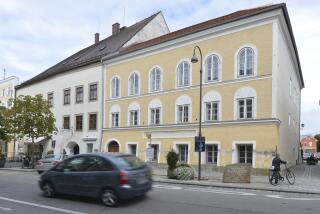Debate Rages Over What Nuremberg Should Do With Buildings From the Nazi Era
- Share via
NUREMBERG, West Germany — More than four decades after the end of World War II the southern West German city of Nuremberg is still at a loss over what to do with the grandiose buildings where dictator Adolf Hitler staged his Nazi party congresses.
The 10-square-mile area, the site of the giant congress hall and an ornate building with a platform where Hitler, like a Roman emperor, delivered his speeches to thousands of cheering supporters between 1933 and 1938, is a blank spot on city maps.
The buildings are gradually becoming dilapidated, and no tourist brochure mentions the unwanted heritage that brings back memories of the dark days of the Third Reich, when millions of Jews were gassed in Nazi death camps.
Nuremberg city fathers are wondering what to do with the complex. Should it remain untouched as a memorial of the horrors of Nazi Germany? Should it be turned into a shopping and recreation center? Or should the colossal Nazi temple fall?
A recent seminar of city planners, historians and artists ended without producing answers.
Nuremberg is reluctant to follow the example set by other cities. In West Berlin, for example, the former Japanese Embassy was reconstructed despite numerous protests. In Munich, city fathers long ago simply renamed the former Haus der Deutschen Kunst (House of German Arts), the Nazi art museum, Haus der Kunst (House of Arts), which now features modern art shows.
After Hitler rose to power in 1933, he ordered his chief architect, Albert Speer, to map out a plan for a center where huge Nazi rallies could be staged. Hitler chose Nuremberg as headquarters for his Nazi Party.
Inmates of the nearby Flossenbuerg death camp, where 30,000 people were killed, were forced to work in the quarries where the giant granite stones for the neoclassical buildings came from.
However, only the ceremonial building, its platform and the huge columns were built, while the 120-foot high congress hall, modeled on the Rome Colosseum, remained unfinished.
Until the start of World War II in 1939, up to 250,000 people flocked to the annual Nazi Party congress to hear Hitler. It was there that in 1935 the dictator proclaimed his “race laws”--the basis of the mass killing of Jews.
Ten years later, after the end of the war, the Nuremberg compound became a taboo of which officials did not want to be reminded.
It was used by sports fans who cheered motor-racing stars on the adjacent Noris Ring. Rocks bands staged concerts on the platform where Hitler once stood, and U.S. soldiers stationed in the area used the compound to play baseball.
But for Nuremberg, the site of the postwar Nazi trials of leading Nazi criminals, the buildings were silent witnesses to the past and remained a black spot.
In 1985 the Golden Hall of the ceremonial building was given a face lift and used to stage a show entitled “The Fascination of Violence.”
Hermann Glaser, city official in charge of cultural affairs, said films on the Nazi Holocaust shown then revealed the “contrast between the national dream factory at party congresses and the national death factory at the concentration camps.” But the show did not solve the question of what to do with the Nazi ruins.
Last year the city turned down an offer by an investment firm wanting to turn the area into a shopping center with offices, a swimming pool and a home for old people. Glaser said, “Inhumane buildings cannot be used for humane things.”
The city’s rejection further fueled the dispute.
More to Read
Sign up for Essential California
The most important California stories and recommendations in your inbox every morning.
You may occasionally receive promotional content from the Los Angeles Times.













